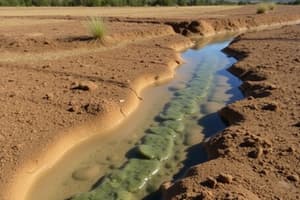Podcast
Questions and Answers
What is the primary benefit of integrating data and disciplines in oil and gas exploration?
What is the primary benefit of integrating data and disciplines in oil and gas exploration?
- Reduces costs associated with exploration. (correct)
- Increases the number of exploration wells drilled.
- Eliminates the need for geological analysis.
- Improves the understanding of multidisciplinary challenges. (correct)
How does the vertical resolution of well data compare to geophysical data?
How does the vertical resolution of well data compare to geophysical data?
- Well data has a higher vertical resolution compared to geophysical data. (correct)
- Both have the same vertical resolution.
- Geophysical data has a higher vertical resolution than well data.
- Vertical resolution is not relevant to exploration.
What is the typical sampling density provided by geophysical data?
What is the typical sampling density provided by geophysical data?
- 5-10 m
- 1-5 m
- 25-50 m
- 10-25 m (correct)
Why is the analysis of well logs important in conjunction with geophysical data?
Why is the analysis of well logs important in conjunction with geophysical data?
What is one of the geophysical tools mentioned that is used in oil and gas exploration?
What is one of the geophysical tools mentioned that is used in oil and gas exploration?
Which of the following best describes the distribution of wells in oil and gas fields?
Which of the following best describes the distribution of wells in oil and gas fields?
How do the applications of geophysical techniques evolve over a reservoir's life cycle?
How do the applications of geophysical techniques evolve over a reservoir's life cycle?
What type of measurements can geophysical methods utilize?
What type of measurements can geophysical methods utilize?
What is the primary purpose of geophysical measurements in drilling?
What is the primary purpose of geophysical measurements in drilling?
Which of the following is NOT a geophysical measurement used in drilling?
Which of the following is NOT a geophysical measurement used in drilling?
What does a reservoir engineer ensure during the drilling process?
What does a reservoir engineer ensure during the drilling process?
Which of the following helps to describe construction hazards during drilling?
Which of the following helps to describe construction hazards during drilling?
What technology is used to capture data about the subsurface in 3D?
What technology is used to capture data about the subsurface in 3D?
Why is it important to update the static model during drilling?
Why is it important to update the static model during drilling?
What can geophysical measurements predict during the drilling process?
What can geophysical measurements predict during the drilling process?
Which of the following models depicts a mismatch between seismic and structural data?
Which of the following models depicts a mismatch between seismic and structural data?
What is the primary focus of geology?
What is the primary focus of geology?
Which method is suitable for studying gravitational attraction in geology?
Which method is suitable for studying gravitational attraction in geology?
What does the term 'seismic refraction' commonly involve?
What does the term 'seismic refraction' commonly involve?
What property does the electromagnetic method measure for shallow near-surface lithology changes?
What property does the electromagnetic method measure for shallow near-surface lithology changes?
Which method is used to investigate radioactive ores?
Which method is used to investigate radioactive ores?
What is analyzed in the geological structures using geothermal methods?
What is analyzed in the geological structures using geothermal methods?
What type of structures can Ground Penetration Radar help locate?
What type of structures can Ground Penetration Radar help locate?
Which measurement is used in magnetic methods to determine geological structures?
Which measurement is used in magnetic methods to determine geological structures?
What do engineers rely on from geophysicists, geologists, and petrophysicists to improve their work?
What do engineers rely on from geophysicists, geologists, and petrophysicists to improve their work?
Seismic reflection is primarily used for what purpose?
Seismic reflection is primarily used for what purpose?
Flashcards are hidden until you start studying
Study Notes
Geophysical Techniques in Drilling
- Seismic reflection methods include 2D, 3D, and 4D imaging to visualize subsurface structures.
- Borehole techniques encompass vertical seismic profiling (VSP), cross-well seismic, microseismic, and borehole gravimetry for enhanced accuracy.
- Essential for understanding geological features from the surface to the target reservoir, ensuring effective drilling operations.
- Geophysical measurements help identify drilling hazards, predict construction challenges, and illuminate conditions surrounding the well bore.
Geology vs Geophysics
- Geology studies the Earth's materials and structures through direct observation and measurement from surfaces and excavations.
- Geophysics applies physical principles to explore hidden aspects of the Earth, providing insight into subsurface geology via indirect measurements.
Geophysical Methods and Applications
- Gravity: Measures gravitational attraction and density contrasts, valuable for identifying geological structures like salt domes and reefs.
- Magnetic and Electromagnetic: Analyze magnetic susceptibility and variations to explore sedimentary structures and archaeological sites.
- Seismic: Includes refraction and reflection techniques to derive geological structures, their history, and reservoir properties.
- Radiometric: Assesses radiation intensity to locate radioactive ores.
- Geothermal: Measures temperature to identify geological formations like salt domes.
- Ground Penetrating Radar (GPR): Utilizes electromagnetic waves to detect subsurface channels and utilities.
Role of Reservoir Engineers
- Must integrate information from geophysicists, geologists, and petrophysicists for effective oil and gas exploration and production.
- As knowledge of geophysical techniques increases, their application in reservoir engineering expands throughout the reservoir’s lifecycle.
- Geophysical data offers continuous spatial coverage (10-25 m) and vertical resolution (10-20 m), superior to sparse well data (0.5 m resolution).
Geophysical Tools and Technologies
- High-precision sensors like geophones, hydrophones, magnetometers, and gravity meters are used to capture physical properties both onshore and offshore.
- Data collected from various sources, including satellites, enhances the understanding of subsurface geology.
Studying That Suits You
Use AI to generate personalized quizzes and flashcards to suit your learning preferences.




